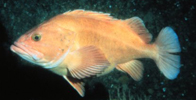Yelloweye Rockfish (Sebastes ruberrimus)
Status | Taxonomy | Species Description | Habitat | Distribution |
Population Trends | Threats | Conservation Efforts | Regulatory Overview |
Key Documents | More Info
Status
Proposed ESA Threatened - Georgia Basin DPS
Taxonomy
Kingdom: Animalia
Phylum: Chordata
Class: Actinopterygii
Order: Scorpaeniformes
Family: Sebastidae
Genus: Sebastes
Species: ruberrimus
Species Description
Yelloweye rockfish are very large rockfish that reach up to 3.5 feet (~1 m) in length and 39 pounds (18 kg) in weight. They are orange-red to orange-yellow in color and may have black on their fin tips. Their eyes are bright yellow. Adults usually have a light to white stripe on the lateral line; juveniles have 2 light stripes, one on the lateral line and a shorter one below the lateral line.
Rockfishes are unusual among the bony fishes in that fertilization and embryo development is internal and female rockfish give birth to live larval young. Larvae are found in surface waters and may be distributed over a wide area extending several hundred miles offshore. "Fecundity" in female yelloweye rockfish ranges from 1.2 to 2.7 million eggs, considerably more than many other rockfish species. Larvae and small juvenile rockfish may remain in open waters for several months being passively dispersed by ocean currents.
Larval rockfish feed on diatoms, dinoflagellates, tintinnids, and cladocerans, and juveniles consume copepods and euphausiids of all life stages. Adults eat demersal invertebrates and small fishes, including other species of rockfish, associated with kelp beds, rocky reefs, pinnacles, and sharp dropoffs. Approximately 50 percent of adult yelloweye rockfish are mature by 16 inches (41 cm) total length (about 6 years of age). Yelloweye rockfish are among the longest lived of rockfishes, living up to 118 years old.
Habitat
Juveniles and subadults tend to be more common than adults in shallower water, and are associated with rocky reefs, kelp canopies, and artificial structures such as piers and oil platforms. Adults generally move into deeper water as they increase in size and age, but usually exhibit strong site fidelity to rocky bottoms and outcrops. Yelloweye rockfish occur in waters 80 to 1560 feet (25 to 475 m) deep, but are most commonly found between 300 to 590 feet (91 to 180 m).
Distribution
Yelloweye rockfish range from northern Baja California to the Aleutian Islands, Alaska, but are most common from central California northward to the Gulf of Alaska.
Population Trends
Recreational catch and effort data spanning 12 years from the mid-1970s to mid-1990s suggests possible declines in abundance. While catch data are generally constant over time, the number of angler trips increased substantially, and there was a decline in the average number of rockfish caught per trip. Taken together, these data suggest declines in the population over time. Currently there are no survey data being taken for this species, but few of these fish are caught by fishermen, suggesting a low population abundance.
Threats
Yelloweye rockfish are fished directly and are often caught as bycatch in other fisheries, including those for salmon. Adverse environmental factors led to recruitment failures in the early- to mid-1990s.
Conservation Efforts
Various state restrictions on fishing have been put in place over the years leading to the current ban on retention of yelloweye rockfish in Washington in 2003. Because this species is slow growing, late to mature, and long-lived, recovery from these threats will take many years, even if the threats are no longer affecting the species.
Regulatory Overview
On April 23, 2009, NMFS proposed that this species should be listed as threatened under the ESA.
On April 9, 2007, NMFS received a petition from Mr. Sam Wright (Olympia, Washington) to list "distinct population segments (DPSs)" of yelloweye rockfish, and 4 other rockfishes in Puget Sound, as endangered or threatened species under the ESA and to designate critical habitat. NMFS found that this petition also did not present substantial scientific or commercial information to suggest that the petitioned actions may be warranted (72 FR 56986; October 5, 2007). On October 29, 2007, NMFS received a letter from Mr. Wright presenting information that was not included in the April 2007 petition, and requesting reconsideration of the decision not to initiate a review of the species' status. NMFS considered the supplemental information as a new petition and concluded that there was enough information in this new petition to warrant conducting status reviews of these rockfishes. The status review was initiated on March 17, 2008 (73 FR 14195).
In February 1999, NMFS received a petition from Mr. Sam Wright of Olympia, Washington to list 18 species of marine fishes in Puget Sound, including this species, under the ESA. On June 21, 1999, NMFS found that there was insufficient information concerning stock structure, status, and trends for this species to suggest that listing this species may be warranted (64 FR 33037).
Key Documents
(All documents are in PDF format.)
| Title | Federal Register | Date |
|---|---|---|
| Proposed Rule to List the Georgia Basin DPS as Threatened Under the ESA | 74 FR 18516 | 04/23/2009 |
| 2008: 90-Day Finding on a Petition to List 5 Rockfish Species in the Puget Sound Under the Endangered Species Act | 73 FR 14195 | 03/17/2008 |
| 2007: 90-Day Finding on a Petition to List 5 Rockfish Species in the Puget Sound Under the ESA | 72 FR 56986 | 10/05/2007 |
| 1999: 90-Day Finding on a Petition to List 18 Fishes in the Puget Sound Under the ESA | 64 FR 33037 | 06/21/1999 |
